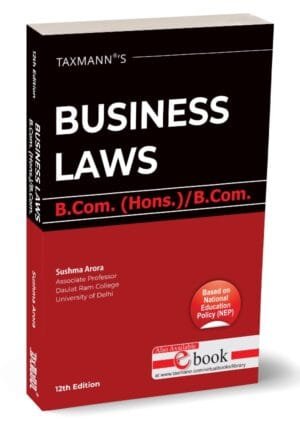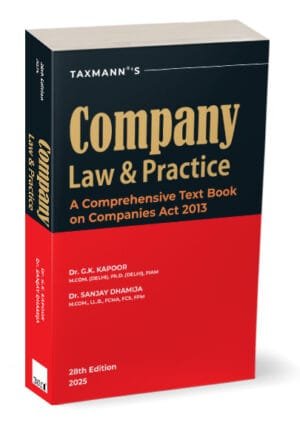Taxmann Students Guide To Income Tax By Vinod k Singhania
Taxmann Students Guide To Income Tax By Vinod k Singhania
Description
Taxmann’s flagship publication for Students on Income Tax has been designed to bridge the gap between theory and application. This textbook is designed with the student in mind, providing a simplified, concise, and well-structured approach. It explains the provisions of the law in a step-by-step manner, supplemented with appropriate illustrations, while avoiding the paraphrasing of sections and legal jargon.
This book is tailored for students pursuing commerce, accounting, finance, and law courses, where a solid understanding of income tax is essential. It is also ideal for professional course aspirants preparing for exams such as CA (Chartered Accountancy), CS (Company Secretary), CMA (Cost and Management Accountancy), and other similar certifications.
The Present Publication is the 71st Edition, authored by Dr Vinod K. Singhania & Dr Monica Singhania, with the following noteworthy features:
- [Updated and Amended] The content is amended up to July 15, 2024, ensuring students have the latest information
- [Self-Learning Design] The book employs a ‘teach yourself’ technique, facilitating faster learning
- [Analytical Discussion] Each paragraph begins with an analytical discussion supported by well-thought-out original problems, illustrated uniquely for better understanding
- [Well-Thought-out-Original-Problems] A unique style of illustrating all complex provisions has been adopted throughout this book
- [e-Filing] Chapter 20 is dedicated to the e-filing of income tax returns, including practical case studies for students to generate e-income tax returns
- [Student-Oriented Book] This book has been developed using extensive student feedback
- [Zero-Error] Follows Six-Sigma Approach to achieve the benchmark of ‘Zero-Error’
The detailed contents of the book are as follows:
Basic Concepts That One Must Know
- This chapter lays the foundation by explaining fundamental concepts such as the assessment year, the previous year, and the definitions of ‘person’ and ‘assessee’. It discusses the intricacies of how income is charged, what constitutes income, and the distinctions between gross total income and total income. The chapter also covers the nuances of agricultural income, exemptions versus deductions, capital and revenue receipts/expenditures, and the relevance of accounting methods in income computation
Residential Status and Its Effect on Tax Incidence
- Understanding residential status is crucial as it directly impacts tax liability. This chapter explains the rules for determining the residential status of individuals, Hindu undivided families, firms, companies, and other persons. It discusses the concepts of income receipt and accrual and provides detailed guidance on income deemed to accrue or arise in India, along with practical problems and solutions
Income That is Exempt from Tax
- Here, the book identifies various income types exempt under section 10 of the Income-tax Act. It includes special provisions for newly established undertakings in free trade zones, export-oriented units, and artistic exports. The chapter also covers exemptions related to charity, political parties, and electoral trusts, supplemented with practical problems for better understanding
Income Under the Head ‘Salaries’ and Its Computation
- This chapter provides an in-depth analysis of salary income, including its basis of charge, different forms, and taxation. It explains the taxability and valuation of allowances and perquisites and details permissible deductions from salary. Special sections cover the tax treatment of provident funds, superannuation funds, foreign technicians, and specific deductions under section 80C. The chapter is rounded off with practical problems in salary income computation
Income Under the Head ‘Income from House Property’ and Its Computation
- Focusing on property income, this chapter outlines the basis of charge, circumstances when property income is not charged to tax, and methods for computing income from let-out and self-occupied properties. It also discusses special provisions for unrealised rent and arrears of rent and includes practical problems to enhance comprehension
Income Under the Head ‘Profits and Gains of Business or Profession’ and Its Computation
- This comprehensive chapter covers the basis of charge for business income, principles for arriving at business income, and the relevance of accounting methods. It provides a detailed look at business deductions, allowances, disallowances, deemed profits, and special provisions for certain businesses. The chapter includes sections on compulsory maintenance of books, audit requirements, estimated income computation, and permissible methods for closing stock valuation, supported by practical problems
Income Under the Head ‘Capital Gains’ and Its Computation
- Capital gains are analysed in this chapter, starting with the basis of charge and definitions of capital assets and transfer. It explains the computation of capital gains, full value of consideration, and expenditure on transfer. The chapter also discusses the cost of acquisition/improvement, indexed cost adjustments, special cases, tax on short-term/long-term gains, and valuation by the Valuation Officer, supplemented by practical problems
Income Under the Head ‘Income from Other Sources’ and Its Computation
- This chapter addresses the basis of charge for income from other sources, including dividends, winnings from lotteries, interest on securities, and income from letting out machinery, plant, or furniture. It discusses the taxation of money/property received without consideration, share premiums, advances during capital asset negotiations, sums received from business trusts, life insurance policies, and permissible deductions. Practical problems provide real-world context
Clubbing of Income
- Analysing scenarios where an individual’s income may be clubbed with another’s, this chapter explains the transfer of income without the transfer of assets, revocable transfers, income from assets transferred to spouse or minor child, and tax implications of converting self-acquired property into joint family property. Practical problems illustrate these concepts
Set Off and Carry Forward of Losses
- This chapter covers the mechanisms for setting off and carrying forward losses, including inter-source and inter-head adjustments, and specific provisions for amalgamated and demerged companies or cooperative banks. Practical problems help clarify these complex rules
Permissible Deductions from Gross Total Income
- Detailing the rules for deductions under sections 80C to 80U, this chapter includes deductions for life insurance, pension funds, National Pension System contributions, Agnipath Scheme, medical insurance, treatment for dependents with disabilities, education loans, housing loans, electric vehicle loans, donations, scientific research, and more. It provides practical examples and problems
Meaning of Agricultural Income and Its Tax Treatment
- This chapter defines agricultural income, provides examples of agricultural and non-agricultural income, and explains the tax treatment of partially agricultural income. It also covers the partial integration scheme for non-agricultural income with agricultural income
Individuals – Computation of Taxable Income
- Focusing on individual taxpayers, this chapter explains the components of an individual’s income, the computation of taxable income, and the calculation of tax liability, supported by practical problems
Hindu Undivided Families – Computation of Taxable Income
- This chapter addresses the taxation of Hindu undivided families, explaining the conditions for assessment, computation of taxable income, and tax implications of family partition, along with practical problems
Firms and Associations of Persons – Computation of Taxable Income
- This chapter explains the taxation scheme for firms, including partnership definitions, conditions for deductible remuneration and interest, loss carry forward and set-off, tax liability, and practical problems for firms and partners
Return of Income
- Covering the process of filing income tax returns, this chapter explains who must file, the timing for filing returns and losses, revised and updated returns, Permanent Account Numbers (PAN), Aadhaar requirements, return verification, self-assessment, and different types of assessments, with practical problems
Advance Payment of Tax
- This chapter explains the advance tax scheme, liability, due dates, computation methods, and practical problems related to advance tax payments
Deduction and Collection of Tax at Source
- Detailing the TDS scheme, this chapter covers deduction rules for salaries, provident fund withdrawals, securities interest, dividends, lottery winnings, contractor payments, insurance commissions, non-resident payments, and more. Practical problems illustrate these scenarios
Interest Payable by Assessee/Government
- Explaining when interest becomes payable by the assessee or the government, this chapter provides procedural guidance for calculating interest and practical problems
e-Filing of Income-Tax Return
- This chapter covers the compulsory e-filing of returns, different income-tax return forms, e-filing software, Form 26AS, and includes case studies to enhance understanding
About the Author
Dr. Vinod K. Singhania got his Ph.D. from the Delhi School of Economics in 1976. His field of special interest includes all facets of corporate legislation and corporate economics, especially tax laws.
Associated in different capacities with several professional institutes and business houses in India and abroad, Dr. Singhania has also authored many popular books and software published by Taxmann.
He has to his credit more than 300 research articles that have appeared in leading journals. He has been a resource person in over 800 seminars in India and abroad
Dr. Monica Singhania is an Associate Professor, Faculty of Management Studies, University of Delhi. She is a post-graduate from Delhi School of Economics and a Fellow Member of the Institute of Chartered Accountants of India. She has the distinction of being placed in the merit list of the examinations conducted by both the University as well as the Institute.
She has been awarded Ph.D. in the area of corporate taxation from the University of Delhi. She is the author of 7+ books on direct tax laws and several research papers which have been published in leading journals.
| Weight | 1.022 kg |
|---|---|
| bookauthor | Monica Singhania, Vinod K Singhania |
| edition | 71st Edition July 2024 |
| publisher | Taxmann |
| hsn | 49011010 |
| binding | Paper back |
| language | English |
| isbn | 9789357782326 |
Related products
Original price was: ₹995.₹795Current price is: ₹795.





